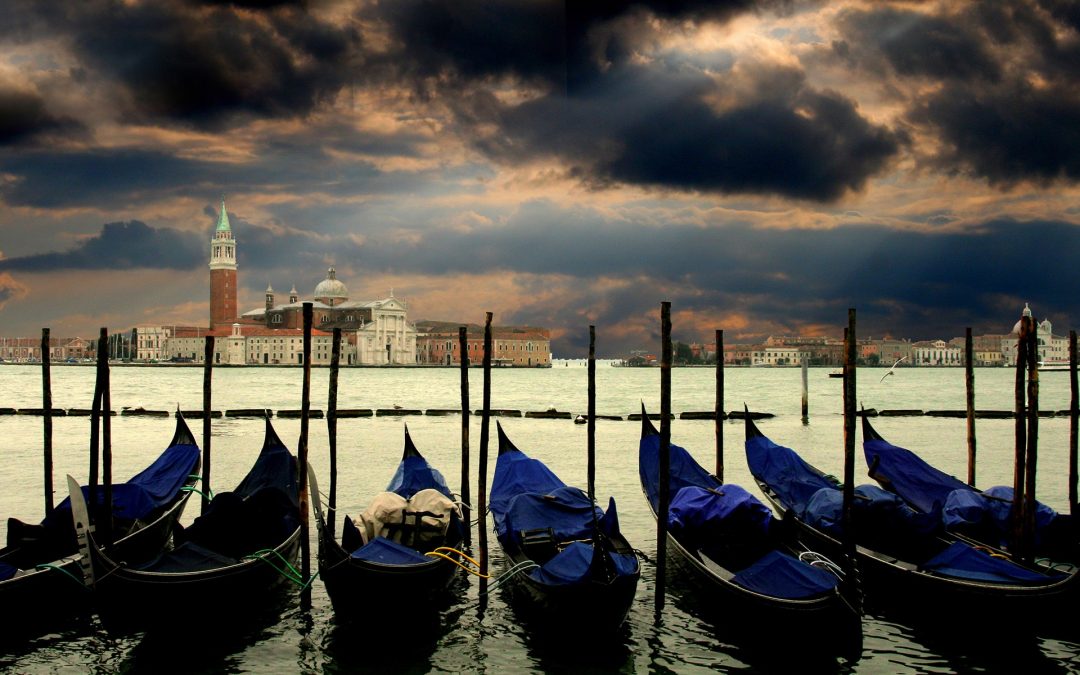Thinking of a holiday abroad this year? Nicole Buckler recommends getting your gondola on and heading for Venice to enjoy it in all its shabby-chic glory. Because within our lifetime, it could be gone.
Shabby-Chic Glory
In the Italian novel Invisible Cities, Kublai Khan points out to Marco Polo that for all the beguiling cities he has described in great detail, Venice was not given a mention. To this, Marco Polo fictionally replies “Every time I describe a city, I am saying something about Venice.”
Venice is famous for a reason. It is absolutely, hopelessly, achingly gorgeous. And I am a touro-sceptic, being very dubious of any place that is so overrun by tourists that they outnumber the local population. This is certainly the case in Venice, the city of liquid boulevards. As cynical as I am, I was still monumentally impressed in spite of myself. You would not be human if you didn’t love the place hard.

Nothing could detract from the city’s charm and its intriguing similarity to postcard pictures that everyone has seen all their lives before arriving. No vile tourist behaviour or damp mouldy hotel or overpriced bland carbonara pasta dish could take away the feeling that Venice is the mythical Atlantis of Italy that never sank (until now). The only way to see how exquisite Venice really can be is to use your feet and a swanky pair of shoes.
Getting Around
The street names and general haphazard geography are derived from a system that was perfected in in Bizzaro World. However stumbling aimlessly amongst the antique pavements and frighteningly green canals is what you should be aiming for.
Try to shun the main drag for a while, and you’ll find that only just two streets away is the real Venice. It is a little bit shabby, a lot quieter, and peopled by genuine Venetians in the flesh, who walk by with an air of business-as-usual. These same Italians have no reservations whatsoever about hanging their underwear out of their windows over the narrow canals. This is for every tourist to be educated as to which style the ageing Venetians prefer (uniformly large and white in fact.) It is amongst these said alleys that you will stumble upon baroque backstreet churches and gorgeous food shops. The local fare is presented so delectably in the windows that it looks like a painting.

Piazza San Marco
Follow the sporadic signs and the general flow of the tourist river, and you will stumble upon the piece de resistance of Venice, the Piazza San Marco. St Mark’s Square has for centuries been inundated by human visitors and pigeons. The latter take the form of face-seeking missiles for most of daylight hours.
The square is bordered by the amazing San Marco Basilica, a spectacular place of worship. And, the Palazzo Ducale, a pink and white Venetian Gothic palace which is the political heart of Venice (also dubiously known for its now disused torture chambers). It is also flanked by the 15th Century Torre dell’Orologio. This a tower within which a huge bronze bell is chimes every hour. The square is lapped by one of the largest canals of the region, the Grand Canal. Gondolas line up along it so that even the most photographically challenged person in the world can take a supremely magnificent photograph.

It is business as usual for the cafes of St Mark’s Square, despite the never-ending floods.
Gumboots at the Ready
For an outrageously priced, bank-breaking cappuccino, you can sit in one of the two outdoor cafes in St Mark’s Square. Here, you can listen to the live orchestras that compete for airtime. Even if you have to remortgage your house to do it, it will be the most scenic coffee you will ever consume Italiano style.
St Mark’s is situated at one of the lowest parts of the city. So when high tides come to visit, the square is covered in water. Absolutely lovely in the moonlight, but for locals an increasingly damp annoyance. It’s a great irony that the element that made Venice so renowned is now threatening its very existence. The city can no longer hold back the rise of the surrounding tidal waters. I was told that the piazza is now almost fully immersed in seawater during autumn and high tides. Raised wooden walkways are placed around the square so that tourists can still mill about the piazza. But, expect wrecked shoes and being salted by the oncoming ocean.
Alas. Venice flooding is getting worse. Unfortunately the grand plan drawn up by the city to stop such flooding isn’t going to save it. Recent storms in 2018 put 70% of the city underwater. Without intervention, Venice will be gone by the year 2100.

Raised walkways are now a perpetual fixture in the sinking city.
St Mark’s Basilica
St Mark’s Basilica is the world’s most spectacular place to go about your worshipping business. It is living evidence of Venice’s maritime and commercial might in a previous era. The Basilica is famous for holding many treasures; most of them plundered from different places across Europe. In this department, Constantinople seems to have lost most booty to the plundering Venetians. It is said that the dodgy Venetian merchants even nabbed the bones of St Mark. They shipped them from Alexandria, and built the church specifically to house his remains, hence the name.
The interior is indeed dazzling, with marble and pure gold floors. It has sparkling mosaics made with centuries of concentration from skilled artisans. It is proof that 12th-Century Venetians must have experienced a disco era after all. The Basilica feels like a leaking spiritual phenomenon with its uneven sinking floors. You can’t help but wonder how many people have sat at its pews and prayed for the best over the many centuries of its existence.

St Mark’s Basilica is Italy’s most famous church outside of Rome. It’s opulent design, with gold ground mosaics, made it a symbol of Venetian wealth and power. From the 11th century onward, the building has been known by the nickname Chiesa d’Oro (Church of gold).
The Canals
Nothing flavours Venice better than the gondolas. Some boats (perhaps meant to attract honeymooners) feature bright red vinyl seats with fluffy heart-shaped cushions. They look like something stolen out of an Italian Iap-dancing club. The gondolas are expensive and embarrassing to be seen in, but they come with a singing Italian, bleating out all your Italian classical favourites. This is while trying to steer amongst all the other gondolas bobbing about with their stripe-shirted captains. You can’t help but get in one. You’ve come all this way, after all, so you must.
Another alternative is the water taxis which are as expensive as the gondolas but without the corny kinda feeling. However one of the best transport options is the waterbus or Vaporetto. It is a fast and relatively inexpensive method of getting yourself around the pretty city.

Food Delights
Venice, for all its historical splendour and former affluence, has had to come down a peg or two and morph its trading economy into a tourist economy. I was warned that Venetians relieve the frustrations of this decline on tourists by charging outrageous prices and by being a little indifferent. Away from the main tourist strip of bland fast-food pastas and cheap horrendous wines are the backstreet restaurants. On all counts they are reasonably priced and serve up damn tasty Italian food. They are also thronged with local patrons who are friendly and noisy.
Around the Venice International University, the bars are pumping and full of talkative Italian students. The drink of choice is Aperol, a scarily bright orange liqueur, mixed with soda, and at around €2 a pop I was a big fan.
While there are some hotels within the city, they are very expensive and can be difficult to access with a suitcase on wheels. A good alternative is to stay on the mainland in a town called Mestre, which is still considered a part of Venice. Prices are much more affordable, and public transport to the island of Venice is cheap and fast, taking around 10 minutes to cross the bridge to get you there.

Getting There
Most visitors flying into Venice land at Marco Polo airport, 12km from Venice. The budget flights will land at Treviso’s minuscule airport, north of the city. Venice in summer is jam-packed and sweltering. You’ll have to offer many sacrifices to the sun gods to get a patch of sand on one its very few beaches. The European Spring is a great time to go (March through to May). European Autumn is also a good time to go, starting in September after the European school holidays have finished. If you like waterlogged feet, be sure to visit in winter. Crowds will be smaller and lines shorter. Don those gum boots and you’ll do just fine.
Author bio

Nicole Buckler Editor-in-Chief
Nicole Buckler has been a journalist for over 20 years, working in Brisbane, Sydney, Melbourne, London, Dublin and Taipei. She recently returned to the Gold Coast, saying she has seen the world but the best place on earth is right here, and she’s never leaving again. You can contact her at Nicole@sunkissmedia.com.au

Editor for Silver Magazine Gold Coast

